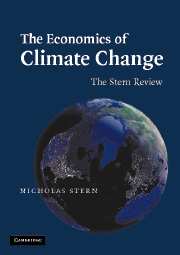Book contents
- Frontmatter
- Contents
- Preface
- Acknowledgements
- Introduction
- Summary of Conclusions
- Part I Climate Change – Our Approach
- Part II Impacts of Climate Change on Growth and Development
- Part III The Economics of Stabilisation
- 7 Projecting the Growth of Greenhouse-Gas Emissions
- 7A Climate Change and the Environmental Kuznets Curve
- 8 The Challenge of Stabilisation
- 9 Identifying the Costs of Mitigation
- 10 Macroeconomic Models of Costs
- 11 Structural Change and Competitiveness
- 11A Key Statistics for 123 UK Production Sectors
- 12 Opportunities and Wider Benefits from Climate Policies
- 13 Towards a Goal for Climate-Change Policy
- Part IV Policy Responses for Mitigation
- Part V Policy Responses for Adaptation
- Part VI International Collective Action
- Abbreviations and Acronyms
- Postscript
- Technical Annex to Postscript
- Index
11 - Structural Change and Competitiveness
Published online by Cambridge University Press: 05 March 2014
- Frontmatter
- Contents
- Preface
- Acknowledgements
- Introduction
- Summary of Conclusions
- Part I Climate Change – Our Approach
- Part II Impacts of Climate Change on Growth and Development
- Part III The Economics of Stabilisation
- 7 Projecting the Growth of Greenhouse-Gas Emissions
- 7A Climate Change and the Environmental Kuznets Curve
- 8 The Challenge of Stabilisation
- 9 Identifying the Costs of Mitigation
- 10 Macroeconomic Models of Costs
- 11 Structural Change and Competitiveness
- 11A Key Statistics for 123 UK Production Sectors
- 12 Opportunities and Wider Benefits from Climate Policies
- 13 Towards a Goal for Climate-Change Policy
- Part IV Policy Responses for Mitigation
- Part V Policy Responses for Adaptation
- Part VI International Collective Action
- Abbreviations and Acronyms
- Postscript
- Technical Annex to Postscript
- Index
Summary
KEY MESSAGES
The costs of mitigation will not be felt uniformly across countries and sectors. Greenhouse-gas-intensive sectors, and countries, will require the most structural adjustment, and the timing of action by different countries will affect the balance of costs and benefits.
If some countries move more quickly than others in implementing carbon reduction policies, there are concerns that carbon-intensive industries will locate in countries without such policies in place. A relatively small number of carbon-intensive industries could suffer significant impacts as an inevitable consequence of properly pricing the cost of greenhouse-gas (GHG) emissions.
The empirical evidence on trade and location decisions, however, suggests that only a small number of the worst affected sectors have internationally mobile plant and processes. Moreover, to the extent that these firms are open to competition this tends to come predominately from countries within regional trading blocs. This suggests that action at this regional level will contain the competitiveness impact.
Trade diversion and relocation are less likely, the stronger the expectation of eventual global action as firms take long-term decisions when investing in plant and equipment that will produce for decades.
International sectoral agreements for GHG-intensive industries could play an important role in promoting international action for keeping down competitiveness impacts for individual countries.
Even where industries are internationally mobile, environmental policies are only one determinant of plant and production location decisions. Other factors such as the quality of the capital stock and workforce, access to technologies, infrastructure and proximity to markets are usually more important determinants of industrial location and trade than pollution restrictions.
- Type
- Chapter
- Information
- The Economics of Climate ChangeThe Stern Review, pp. 282 - 296Publisher: Cambridge University PressPrint publication year: 2007



